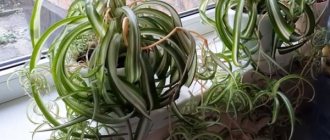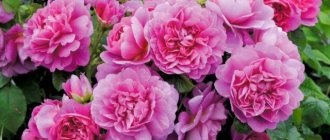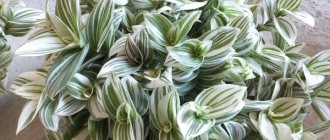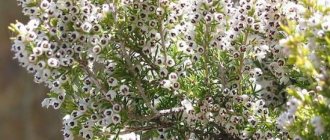The indoor azalea is a representative of the rhododendron genus and a close relative of the garden beauties - tall rhododendrons. There are several hundred species in the wild, but only two and their hybrid forms are grown at home.
The indoor azalea flower is a compact shrub 30–50 cm high with abundant and very beautiful flowering, which has made it popular among indoor plant lovers. Its flowers are lush, in shades of red, white and pink, there are varieties with lilac and two-color corollas. Azalea is also valued because it blooms in the cold season, when most other flowering plants are dormant.
Types and varieties of indoor azalea
There are two types of indoor azaleas.
Indian azalea (indica), or Sims' rhododendron (Rhododendron simsii) (1). The most popular type, it is the one that can most often be found on sale. It is an evergreen shrub with small dark green leaves with reddish pubescence. The flowers of this indoor azalea are simple or double, usually reach sizes of 3 - 5 cm or larger and are collected in round inflorescences.
Japanese azalea, or blunt rhododendron (Rhododendron obtusum) (2) . Less common. Its flowers are small compared to Indian ones and more neat in shape. Japanese azalea can also be grown as a garden plant.
As for the varieties of azaleas, they are mainly known only to collectors: in stores and shopping centers, hybrid azaleas are most often sold, which are usually called “Azalea white / pink / red” or “Azalea mix”, and sometimes simply “Azalea indica” . Azalea varieties may differ in flowering time: early winter or mid-winter - early spring. Unfortunately, it is unlikely that you will be able to find out such details when buying an azalea in a store - the characteristics of the variety (and at the same time its name) can only be found out when purchasing a plant from a collector.
The most famous of the old varieties are (3):
- Adventsglocken - a tall (45 - 50 cm) variety with single large (6 - 8 cm) raspberry-pink flowers that stay on the plant for up to 20 days;
- Vervaeneana - a tall variety with semi-double large flowers (8 - 8.5 cm) of pink color with a white border along the edges of the petals, blooms for 190 days;
- Max Schäme - tall, with double flowers with a diameter of 8 - 8.5 cm, petals of a salmon shade strongly corrugated along the edge, blooms for 130 days;
- White Niobe (Niobealba) is a tall (45 - 60 cm), spreading azalea with white double flowers with a diameter of 8 - 9 cm, blooms for 80 days;
- Schnee is a tall variety with semi-double white flowers, blooms for 130 days.
What it is?
Brief biological description
According to its description and characteristics, azalea is classified as an evergreen shrub, the height of which varies from 50 to 150 cm. Its scientific name is Azalea. The flowering period depends on the plant variety. It is abundant and the flowers are large. They have different colors.
What does a houseplant look like?
The elliptical leaves of the plant are small in size.
They are dark green in color, slightly shiny on top and very soft to the touch. Most often omitted. The flowers have a tubular funnel-shaped or flat shape. They form on the tops of last year's shoots. Flowers can be either single or bicolor. The color can be very different. Flowers are:
- Simple - have about 5-6 petals and 5 stamens.
- Terry - they have a different number of petals, which can grow directly from the stamens.
- A flower within a flower has 112 petals, as well as a cup that forms the petals.
Certain plant varieties have a pleasant aroma.
Passport
Azalea belongs to the genus Rhododendron and the Heather family . There are about 1000 species of this plant. Azalea is a small shrub that blooms in indoor conditions in the winter.
Country of origin
Its homeland is Japan and China. In the natural environment it is also found in North America, as well as in the southern part of Europe.
6.Purpose
This is a valuable ornamental plant with a long flowering period . A living bouquet that, under proper conditions, will flourish for many years.
Azaleas are often used to create flowering bonsai .
Azaleas can be shaped as an attractive standard tree .
↑ Up,
Where did the name come from and what does it mean?
Azalea
Azaleas are certain types of Rhododendrons that are adapted for growing at home. The name of the flower translates as “dry”. It is related to the appearance of the plant, as it is a dry shrub.
Rhododendron
It was customary to include all evergreen species of this plant that grew outdoors as Rhododendrons. Only deciduous indoor species were called azaleas. The name is translated from Greek as “rose tree”.
Azalea and rhododendron - are there any differences?
What is the difference between azalea and rhododendron? There are no differences between these two plants. It’s just that among all the species of the genus Rhododendron, ordinary people have identified several of the most beautiful varieties and combined them into a group under the name “azalea”.
According to one version, the difference between this group and the rest of the genus is the number of stamens: azaleas have no more than 5, while other flowers have more than 10.
There are also differences in the life cycle. Although the azalea is commonly considered an evergreen shrub, it is not. She is deciduous. Rhododendron is an evergreen plant, which people try to grow in open ground. But azalea is mainly an indoor or greenhouse plant.
In botany, azalea is a subgenus of the genus Rhododendron. But since azalea is deciduous and not evergreen, it is treated as a separate flower.
What is the lifespan and can it be extended?
The flower can grow for 5-6 years. In order to extend the flowering period of a plant, the gardener must comply with conditions that rely on natural adaptations.
The lifespan depends on how the azalea goes through the seasons. She needs a period of rest and should sometimes be taken out into the cold. Azalea loves bright light, but does not tolerate sun very well. It should be kept in a bright, cool room. This could be a winter garden, a frost-free balcony or a greenhouse. If you follow these recommendations, you can extend its flowering period.
How it is used in landscape design
Low varieties of Azaleas can be planted in groups or along paths and paths . They will look beautiful if combined with low conifers such as juniper.
Azalea will be a good decoration for any garden
Tall ones are planted in the background of landscape designs or as tapeworms in the center of a flower bed. Using tall varieties, if winters permit, you can make living, beautifully flowering fences.
Whatever variety is chosen when decorating a garden or flower bed, it will be a truly royal decoration.
Benefits and harms
- First of all, her appearance alone can lift a person’s mood. In addition, it is believed that people who grow azaleas rarely experience depression.
- The plant purifies the air and brings pleasant floral freshness to the room.
- The flower also has medicinal properties. If a person has barley, then you need to apply a plant petal to it, after which it will soon go away.
The harm of azalea lies in the fact that its leaves cannot be eaten. If a person does eat the leaf, his heart rhythm will be disturbed, and intestinal colic will begin. Therefore, you need to ensure that children and pets do not eat its leaves.
It also tends to saturate the air with a strong and persistent aroma during flowering, which can cause headaches and allergies in the form of spots on the skin.
In addition, rhododendron can be used to make an invigorating and healing tea. Read about how to do this correctly, as well as the benefits and harms of the drink here.
Bloom
When and how
Early varieties bloom in April, but generally the flowering time is late May - early June. They bloom generously and abundantly; some varieties can bloom a second time, in mid-autumn.
Important: to prolong flowering, you need to constantly clean the flower from already withered inflorescences.
Before and after
During bud formation, the temperature should be reduced to 10 °C. During flowering, the temperature can be increased by 5 degrees, and good lighting is necessary. After flowering, young, elongated shoots are pruned for further cuttings. It is recommended to remove old inflorescences.
During the active flowering period, do not spray - unsightly spots appear on the flowers.
What to do if it doesn't bloom?
Be sure to examine the bush for the presence of parasites and pests - they inhibit the growth and flowering of hybrid rhododendrons. Perhaps the flowers lack moisture. It is necessary to adjust the watering and cover the pot with ice. In summer, daily spraying of foliage is mandatory.
Perhaps the substrate lacks minerals; you can feed it with fertilizers specifically for this type of rhododendron.
Types and photos
It is customary to distinguish 2 main types of plants, from which subspecies originate:
- Indian azalea - it has luxurious funnel-shaped flowers, the size of which is 3.5 cm. The shoots are covered with bristles.
- Japanese - it is characterized by glossy leaves. The diameter of the flowers is 3 cm. It is a recognized national plant in Japan.
Next in the photo you can see what a rhododendron looks like in a pot in an apartment, what color it comes in, and there is also a full-length photo of the plant at home.
Description of the azalea plant
The flower reaches up to 10 cm in diameter and looks very impressive. The bushes bloom for about a month, but given the specific and varied varieties, flowering lasts from autumn to late spring. The height of Azaleas is usually 25 - 50 cm. Tall types of azaleas are presented in the form of a small tree. Dwarf azalea is widespread.
The genus consists of low-growing, creeping, or tall, straight shrubs. Prefers a temperate or cool climate, often in the northern hemisphere. Nowadays, no more than 10 types are used. Azalea pleases the eye with abundant and varied flowering: double, ruffled, fringed and regular flowers with a large palette of colors (pink, red, purple and white).
They give a flower during the flowering period, but after a short period of time, the bush dries up.
Growing at home
Let's look at 3 common methods of planting azaleas, which have significant differences among themselves.
Seedlings
Best suited for a plant that was purchased recently. Planting is carried out in the spring after the flowering period ends. To do this you need:
- Place the pot of azaleas in water to moisten the soil and root system. 20 minutes will be enough.
- After this, you need to remove the flower from the pot and use a knife to cut it into 2-3 parts. This must be done carefully so that the root system is not damaged. If possible, it is best to untangle the tangled roots by hand.
- Without shaking the soil from the roots, the plant should be immediately planted in a pre-prepared pot that contains a drainage layer.
Seeds
Not the easiest way, but also popular:
- It is also held in the spring . The seeds of the plant need to be mixed with sand, after which they are ready for sowing on the surface of the soil.
- Crops need to be covered with film . There should be high humidity inside and a temperature between 23 and 25 degrees Celsius.
- After 3-4 weeks the first shoots will be noticeable . After leaves appear on them, they need to be picked. If the seedlings are 12 cm high, they should be planted in separate pots.
Cuttings
Thanks to this planting method, after 2 years the gardener will be able to enjoy mature plants. The landing principle is as follows:
- It is necessary to cut cuttings from the tops of last year's shoots.
- Rooting is carried out in greenhouse conditions. To do this, you need to deepen the cuttings 2 cm into a light, loose substrate. Then they need to be watered moderately and also sprayed with water. The greenhouse should be ventilated regularly. Temperature: 25 degrees Celsius.
- When the cuttings have their own shoots, they can be taken from the greenhouse. Then plant the plants in pots.
Read more about the azalea root system and how to root the plant here.
When planting azaleas, it is very important to choose the right soil so that the rather finicky flower to care for will feel great both during normal propagation and when grown in a trunk.
Azalea in signs, dreams and folk traditions
In the tradition of many peoples familiar with azalea, the plant is associated with certain natural and even supernatural forces. So in Europe they believe that an azalea in the garden or in the house will help its owner find happiness and become more patient, persistent and diligent. A pot with an azalea plant near a creative person’s desk will attract inspiration and give the strength to bring what he started to a successful completion.
There is an opinion that a flowering bush in a dream symbolizes near prosperity, but the meaning of an azalea that has already faded is the opposite. Such a bush in a dream is a sign of a long wait for your life situation to change for the better.
The popularity of azaleas in European countries and Russia increased sharply with the beginning of the Art Nouveau era.
The amazing forms of azalea flowers, shoots and leaves delighted poets, jewelers and artists. Dozens of drawings and paintings, poems and prose have come down to us, where the authors paint graceful flowers. Among those who were inspired by azalea plants: N. Gumilev and A. Fet, A. Kuprin, K. Paustovsky and D. Mamin-Sibiryak.
But long before them, the beauty of the azalea was sung by the great Basho, who in laconic lines of a haiku compared the flowering of this shrub with a rainbow.
Hill by the road.
To replace the melted rainbow -
Azalea in the rays of sunset.
For the Japanese, who treat all living things with reverence and respect, the azalea is no less significant than one of the symbols of the nation - sakura. The flowers of the bush are dedicated to the sensual beauty of women, and also believe in their ability to enlighten thoughts.
Features of care
Lighting in an ordinary apartment should be diffused; light partial shade from northern or western window sills is allowed. In order for the plant to grow and develop normally, the room temperature must be maintained at 15-18 degrees Celsius. Azaleas need to be watered very often and abundantly. This must be done every day.
The frequency of watering depends on the level of air humidity. It is recommended to place pieces of ice on the surface of the soil, which will melt and thus saturate the substrate with moisture, as well as refresh the flower on summer days.
Periodically, it is necessary to dissolve a teaspoon of lemon juice in 2 liters of water, and then water the plant with this mixture. With the arrival of autumn, you should water the plant less often. When the flowering period begins again, it should again be frequent and abundant.
Azalea needs high air humidity . The plant should be sprayed. It can also be placed on a tray with wet pebbles.
As for feeding, in summer and spring it is carried out once a week. With the onset of winter cold, the plant needs to be fertilized once a month. As a top dressing, you should use a special mineral complex for Azalea. Any other compositions that are intended for flowering plants and do not contain chlorine are also suitable.
When the active growth of the plant begins, the gardener needs to shorten the shoots that have grown strongly. During the growing season, you need to pinch the tops, so that the azalea will not bush too much, and the flowering will be abundant. Transplantation is carried out only when the plant becomes cramped in the pot.
After flowering, the plant begins a dormant period that lasts 2 months.
We invite you to watch a video about the features of caring for azaleas:
Features of pruning, fertilization
The main type of fertilizer for azaleas is superphosphate. With intensive growth, replenishment is introduced 3 times a month. Dosage: 15 g of the drug per 10 liters of water.
When forming buds, the bush needs iron. To replenish a sufficient amount of this element, growth stimulants and commercial nutritional formulations intended for this plant are used.
In order not to harm the flower by choosing the wrong fertilizer, it is recommended to use specialized formulations for azaleas and strictly follow their instructions.
It is best to use special means
Pruning is carried out upon completion of flowering. As soon as all the buds have faded, you need to wait 2 weeks and remove the dried ones, as well as the branches that greatly thicken the plant. The remaining shoots are cut to 1/3 of their length.
After pruning, the cut area must be treated with a garden decoction.
To maintain the lushness of the bush, pruning is carried out along the entire periphery.
Flowering and what to do if it doesn’t bloom?
The flowering period varies from 2 to 6 months. Lasts from December to March. It happens even until April. In most cases it blooms very luxuriantly and abundantly. Flowering may not occur for the following reasons:
- The flower is kept in too warm conditions.
- The soil does not receive the necessary nutrition.
- The flower is in the open sun or in a too dark place.
- No pruning or pinching was done.
In this case, it is necessary to determine the reason for the lack of flowering and correct it.
Types of azaleas for the garden
The following varieties of rosewood are usually grown in summer cottages and gardens:
| View | Description | Flowers | Bloom |
| Homebush | Reaches 1 m. | Terry, pinkish-raspberry. Resistant to frost. | May June. |
| White | Visually similar to a jasmine bush. | Terry and simple, whitish or light pink. | From May. |
| Nabucco | Up to 200 cm, with a spreading crown. | Wide open, bright red. | Summer. |
Briefly about reproduction
This plant is propagated by stem cuttings. The most optimal time for reproduction is summer .
- Semi-lignified cuttings with buds must be planted in the ground.
- Any flower buds that appear should be removed immediately.
- A few months later, the cuttings are planted in a pot.
We invite you to watch a video about how to propagate azaleas:
Propagation of azaleas by stem cuttings
The easiest way to propagate azaleas is by cuttings. It is best to carry out this procedure in the summer. Semi-lignified cuttings on which buds have appeared are planted in prepared soil and covered with a jar or polyethylene. The cover is regularly removed to moisten and ventilate the plant. Flower buds may appear and should be removed immediately. After about 2 months, the shoots take root. Then they move to a new place.
Important! If the shoots stretch out, they need to be pinched on already rooted shoots. Pinching is also needed to form the crown.
Diseases and pests
- If the azalea leaves turn yellow, begin to wither and fall off, this indicates improper watering or exposure to direct sunlight. To solve the problem, you need to follow the watering rules, spray the plant and hide it from the sun.
- If gray rot or rust appears, the temperature in the room should be adjusted, and all damaged leaves of the plant should be removed.
- Excess moisture in the soil leads to late blight, which can cause the plant to die.
Pests that can harm azaleas:
- scale insects;
- strawberry and spider mites.
To solve the problem, you need to use special products that treat the leaves of the plant.
You can read more about pests and diseases of azaleas in a separate article.
Where is the best place to place Azalea?
Choose your location carefully. Diffuse light is ideal for azaleas; at midday the sun's rays should not hit the plant. The best option is an east or west window, but not a south one. Throughout October you will need to provide additional light to the azalea. Only then does it bloom in February.
Lighting. Azaleas need very good lighting. However, the plant must be protected from direct sunlight.
In the open air, rhododendrons are usually planted under trees with a sparse crown - for example, conifers.
Temperature.
Azalea loves light, but hot conditions are not suitable for it. However, at high temperatures, azalea also does not feel very good - 18-20 degrees is optimal for it. Therefore, the plant is often grown in offices or on glazed balconies. Keep the plant away from heating devices, and even better, if possible, take it to a glassed-in balcony or terrace. In cold winter conditions, rhododendrons are brought into the garden only for the period from April to October. The plant should spend the winter season in a heated room. But do not keep the flower in a draft.
Humidity.
Water the plant regularly. In addition, you need to spray the room and the plant itself. Just don't get on the flowers! You can place a container of water next to the azalea. In hot weather, you can water it every day, but it is better to do it through a tray. Sometimes add a couple of drops of lemon juice to the water. Never water a flower with tap water! Let the water sit for at least two days.
What similar plants are there?
- Daurian rhododendron - it has small leaves and branches directed upward. It can be up to 2 m in height. The flowers are funnel-shaped. They are pink-purple in color and very large.
- Canadian rhododendron is a low-growing shrub, the height of which does not exceed 1 m. It has very long leaves - up to 6 m. The flowers are pink-purple in color.
- Jasmine gardenia is a very small bush, the height of which varies from 45 to 50 cm. The leaves are dark green and the flowers are white and double. It has a very pleasant smell.
Inexperienced gardeners may confuse azaleas with other unusual plants. You can read about its similarities and differences and other colors in our material.
This flower can become the main decoration of any home, but to do this you need to know everything about the specifics of growing azaleas at home. Otherwise, you won’t be able to see the beautiful flowering of the plant.
How to Grow Azalea Bonsai
Bonsai is a tree in miniature. It can be formed from either an outdoor Azalea or an indoor one, but there will still be a difference in the height of the bush. But the most beautiful creations are those that nature makes with its own hands. But a person with imagination and taste for shaping a bush can always create a bonsai for himself.
There are different forms of bonsai for Azalea:
- Cascade;
- Spiral;
- Sloping, when the top tilts in opposite directions.
Azalea bonsai
All pruning of the flower is carried out in the spring at the time of active growth of the stems and before the onset of summer heat. When trimming a plant, you should be careful about its top , since if you trim it, the side branches will begin to grow much faster. This pruning period occurs after flowering and transplanting the plant into a new container.
Pruning is done with sharp pruning shears or a knife disinfected in medical alcohol. When pruning a plant, you don’t need to chop it too much, because if you overdo it with pruning, the plant will hurt for quite a long time and will slowly increase its green mass.
Capricious sissies or undemanding ascetics
For a long time, Russian gardeners avoided rhododendrons. The plants were considered finicky and completely unadapted to the climatic conditions of Moscow and the middle zone. Therefore, the main attention was paid to potted varieties. Azalea flowers were mainly admired by greenhouse owners.
Indeed, among these shrubs there are many heat-loving varieties. However, through the efforts of German breeders, frost-resistant varieties of rhododendrons and hybrids of deciduous azaleas for the garden appeared. We have long been fruitfully cooperating with the most famous nurseries in Germany. We deliver magnificent German plants in a short time and in compliance with all transportation rules.
Step-by-step care instructions
Place
Does not tolerate direct sunlight, prefers partial shade in a place protected from draft winds. It is better to plant near coniferous trees and ponds. Requires good moisture, close to the natural conditions of the tropics. It is better to choose areas adjacent to the northern part of the dacha or house.
The soil
The soil must be acidic; when watering, purified acidified water must be used.
Drainage is required.
Substrate composition:
- Leaf soil - 3 hours.
- Peat – 2 hours.
- Coniferous litter – 1 hour.
- Mineral fertilizer granules.
Landing
Planting time is late spring and autumn.
- Dig a planting hole twice as large in volume as the root system.
- Pre-prepare the earthen mixture.
- A drainage layer of 10–15 cm is desirable; it is laid out at the bottom of the pit.
- The bush is placed vertically. The substrate around the root is pressed well; there should be no air pockets in the planting soil. Cover with soil up to the root collar.
- Mulching is mandatory - use peat chips or sawdust.
Temperature
The optimal temperature for hybrid rhododendrons is 10 – 15°C. In summer, in the heat, with shading and regular spraying, this species can tolerate heat of 25 - 30°C. Hybrid varieties of rhododendron are quite frost-resistant; they can withstand temperatures down to -25°C.
Watering
At the time of planting or transplanting, hybrid rhododendron requires abundant moisture to a depth of 25 - 30 cm of the substrate. In summer, water daily with warm purified water. In winter and autumn, watering is reduced.
Attention! It should be watered over the entire surface of the substrate so that the roots are not washed out.
In late autumn and winter, watering can only be done in dry weather.
Top dressing
In the first year after planting, hybrid rhododendron varieties require feeding - reduced portions, well diluted solution. Organic fertilizers: manure, well diluted in water.
Superphosphate in granules is also used to prolong flowering and the formation of new buds.
Fertilizer with microelements - spray the leaves. Intensive fertilizer - once a week until the end of summer. Combine with watering.
Trimming
To maintain a beautiful compact crown shape and preserve flower buds, regular pruning of old shoots by a third is required. Pruning is done 3 weeks after flowering ends.
Transplantation
Transplantation is carried out in early spring; it can be replanted before and after flowering. Hybrid rhododendrons quickly adapt to new conditions.
When transplanting, the planting bush is surrounded by a border of moss and pine needles, 10 cm high.
Preparing for winter
For the winter, it is better to cover young rhododendrons of hybrid varieties with spruce branches or other dry cover. At the end of spring, the cover is removed gradually to avoid sunburn.
Important: it is advisable to mulch the soil around the root. Proper care is very important for rhododendron. We want to share with you secrets that will help you grow excellent specimens of such varieties as Golden, Cunningham’s White, Yakushemansky, Daursky, Polarnakht, Rasputin, Schlippenbach, Dense, Katevbinsky and Caucasian on your site.
Delicate flowers and poisonous leaves of the plant
Due to the andromedotoxin glycoside contained in the juice, azalea is classified as a poisonous plant. The result of getting it inside the body is poisoning. To prevent such negative consequences from occurring, it is not recommended to keep flowerpots with indoor flowers in places accessible to both children and pets.
It is not advisable to place a pot of azaleas near the bed. Its strong aroma often causes dizziness. In the absence of fresh air, a person may lose consciousness, since the flowering bush contains narcotic substances. People prone to allergies feel their effects almost immediately.
Poisoning occurs especially often in children and cats if the azalea is within reach. Poisonous juice negatively affects the nervous and cardiac systems, as well as the muscular system. If it gets on the skin, irritation will appear instantly. Symptoms of poisoning are similar to gastroenteritis, as severe irritation occurs in the gastrointestinal tract. In such cases, medical assistance cannot be avoided.
Azalea occupies one of the leading positions in home floriculture. It is quite possible to grow this evergreen and flowering shrub, the main thing is to follow all recommendations regarding planting and care.
History and homeland of the plant
The first appearance of azaleas in Europe occurred in the 16th century. It was brought to Holland by the botanist Brainius, but could not take root in the new conditions. Only in 1808, the exotic plant was delivered by Captain Velben to the London Botanical Garden, where conditions as close as possible to its usual environment were created for it. At the beginning of the 20th century, there was high demand for the evergreen and abundantly flowering shrub; the number of its varieties already reached thousands.
The Carpathian Mountains, East Asia and the Caucasus are considered the homeland of azaleas. The name of the flower is of Greek origin and means “rose tree”. The flower of the Rhododendron genus has gained great popularity among lovers of home gardening; it effectively decorates any indoor interior.











